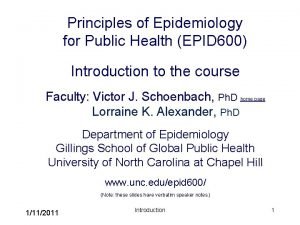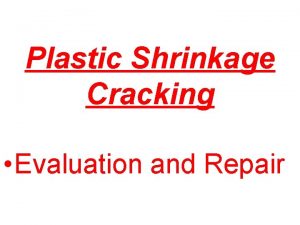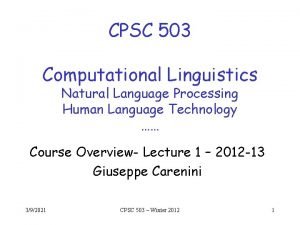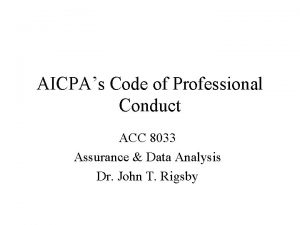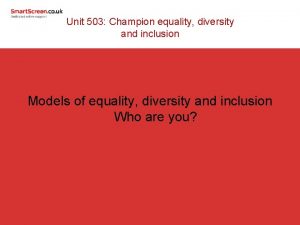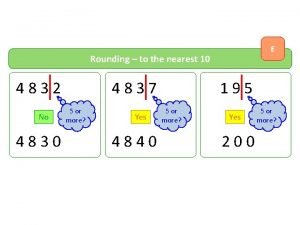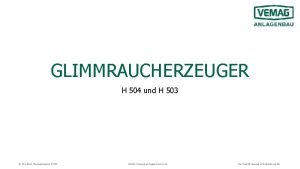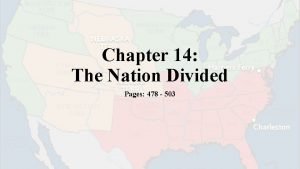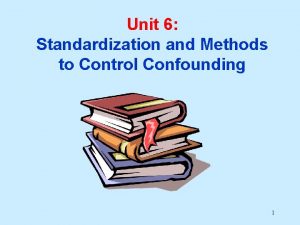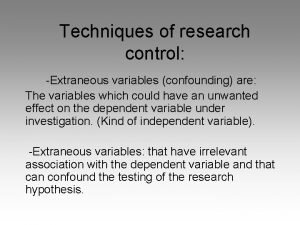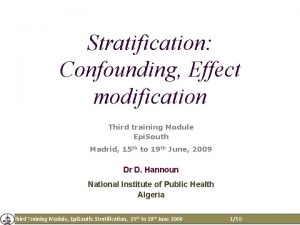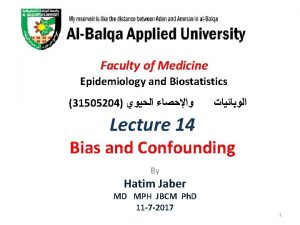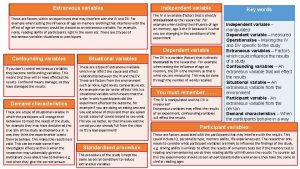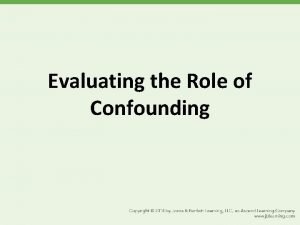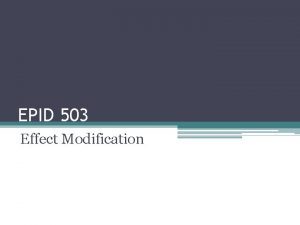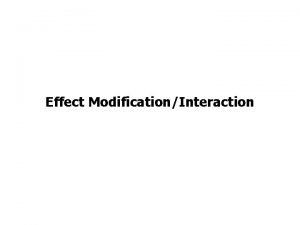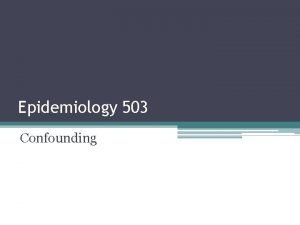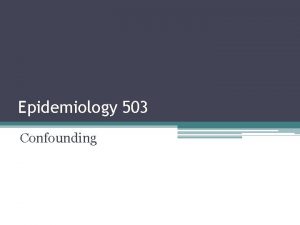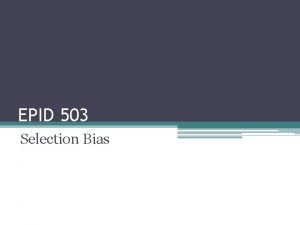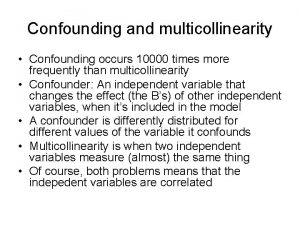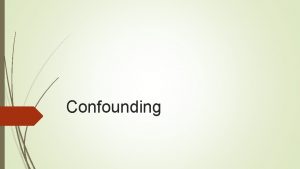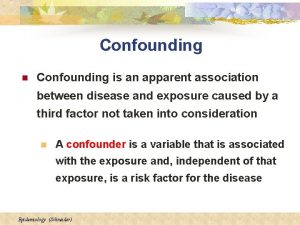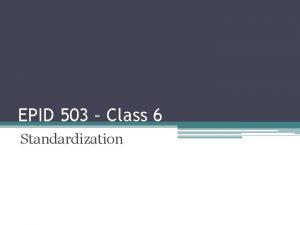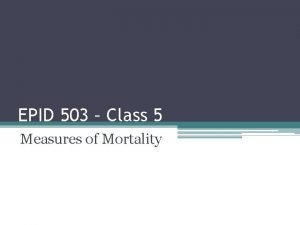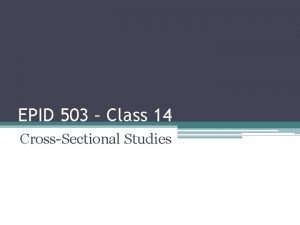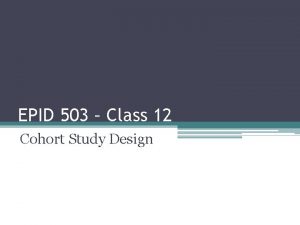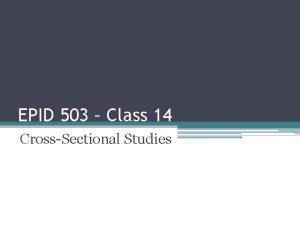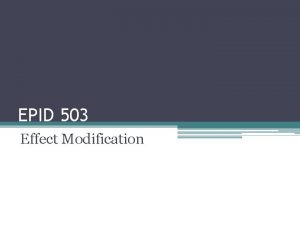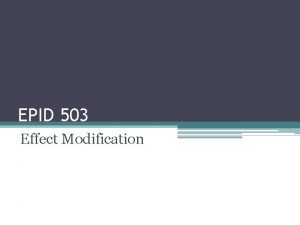EPID 503 Class 21 CONFOUNDING 1 Major Challenges




















- Slides: 20

EPID 503 – Class 21 CONFOUNDING (1)

Major Challenges to Internal Validity 1. Random Error: not a systematic error, but chance or the luck of the draw (sampling error) 2. Bias: a systematic error in design or conduct of study which leads to inaccurate estimate of true association § Selection Bias § Information Bias 3. Confounding: A third variable that is distorting the association between exposure and disease

Confounding • Definition (Szklo): a non-causal association between a given exposure and an outcome is observed as a result of the influence of a third variable (or group of variables) • Definition: The observed association between a given exposure and an outcome is distorted as a result of another variable (other variables) • The true association between exposure and outcome is incorrectly estimated (miss-specified) as a result of the influence of a third variable (or group of variables)

A variable is a confounder; that is, has a confounding influence on observed association between exposure and outcome if: • It is a known risk factor for the outcome • It is associated with the exposure • It is NOT a result of the exposure

Example of Confounded Association

Example of Confounded Association

Confounding in a Causal Diagram Smoking Coffee Consumption Pancreatic CA

Why is Confounding a Problem? Because…. . . • The estimate of association between exposure and disease includes BOTH the contribution of the exposure AND the confounder, • and possibly just the contribution of the confounder

Properties of a Confounder • Predictive of disease among the unexposed Smoking Pancreatic CA among non-coffee drinkers • Associated with exposure in source population Smoking Coffee drinking • Not a downstream cause of the exposure (e. g. , in the causal pathway from exposure to disease) Coffee Smoking Pancreatic CA Confounding can overestimate true association (positive confounding) or underestimates true association (negative confounding)

Examples of No Confounding E D E C D C E C D

Positive and Negative Confounding E + + C D + E + D - + C • Conceptually incorporating effect of E and C on disease • Can use multiplication to help you figure out the directionality (+) = positive confounding, overestimate effect, (-) = negative confounding, underestimate effect

Assessing Confounding in Your Data 1. CALCULATE the CRUDE measure of association between exposure and outcome (RR or OR) 2. ASSESS associations between exposure and disease with confounder 3. CALCULATE the strata specific RRs or ORs 4. COMPARE crude to strata specific RRs or ORs If measure of association is the same in the strata but different than the crude then you have evidence of confounding!

Assessing Confounding in Your Data 1. CALCULATE the CRUDE measure of association between exposure and outcome (RR or OR) 2. ASSESS associations between exposure and disease with confounder 3. CALCULATE the strata specific RRs or ORs 4. COMPARE crude to strata specific RRs or ORs If measure of association is the same in the strata but different than the crude then you have evidence of confounding! Present the stratum-specific effect estimates or calculate a weighted average effect estimate

Step 1: Crude association between coffee drinking and cancer. Coffee None Total Cancer None Total 165 85 250 735 1015 1750 900 1100 2000 Unadjusted RR= (165/900) (85/1100) =2. 37 “Crude RR”

Step 2 a: Is smoking associated with coffee drinking? Cf+ Cf- Total S+ 800 200 1000 S- 100 900 1000 900 1100 2000 PR* for Coffee Drinking Among Smokers vs. Non-Smokers: (800/1000)/(100/1000) = 8. 00 *PR: prevalence ratio

Step 2 b: Is smoking associated cancer among non-coffee drinkers? Ca+ Ca- Total S+ 40 160 200 S- 45 855 900 85 1015 1100 RR for Cancer Among Smokers vs. Non-Smokers who don’t drink coffee: (40/200 )/ (45/900) = 4. 0

Step 3: Is coffee associated with cancer within smoking strata? Non-Smokers D+ D- Total E+ 160 640 800 E+ 5 95 100 E- 40 160 200 E- 45 855 900 200 800 1000 50 950 1000 RR Smoker Strata= (160/800)/(40/200) = 1. 0 RR Non-Smoker Strata= (5/100)/(45/900)= 1. 0

Step 4: Compare strata-specific RR to crude RR • Smoking confounds the association between coffee and cancer because: ▫ The strata specific RR are equal (1. 0) – though they don’t have to be as equal as we observed ▫ The strata specific RR of 1. 0 is NOT the same as the crude RR of 2. 37 • The difference between the strata specific and crude is large so we conclude that this is important confounding ▫ Some people use a 10 or 20% rule as a rough metric of “importance”

Example of Confounded Association

What about this?
 Epid 600 unc
Epid 600 unc Aci crack repair
Aci crack repair Cpsc 503
Cpsc 503 Nacr-503
Nacr-503 What is considered immediate family
What is considered immediate family Humiseal 503
Humiseal 503 Champion equality diversity and inclusion
Champion equality diversity and inclusion What is 503 rounded to the nearest hundred
What is 503 rounded to the nearest hundred Gallimune 503
Gallimune 503 2 687 in scientific notation
2 687 in scientific notation H 503
H 503 503 divided by 3
503 divided by 3 How to control for confounding
How to control for confounding What is extraneous variables
What is extraneous variables Effect modification vs confounding
Effect modification vs confounding Effect modification vs confounding
Effect modification vs confounding Define extraneous variable
Define extraneous variable Confounding variables in an experiment
Confounding variables in an experiment How to control for confounding
How to control for confounding Confounding vs effect modification
Confounding vs effect modification Effect modification vs confounding
Effect modification vs confounding
